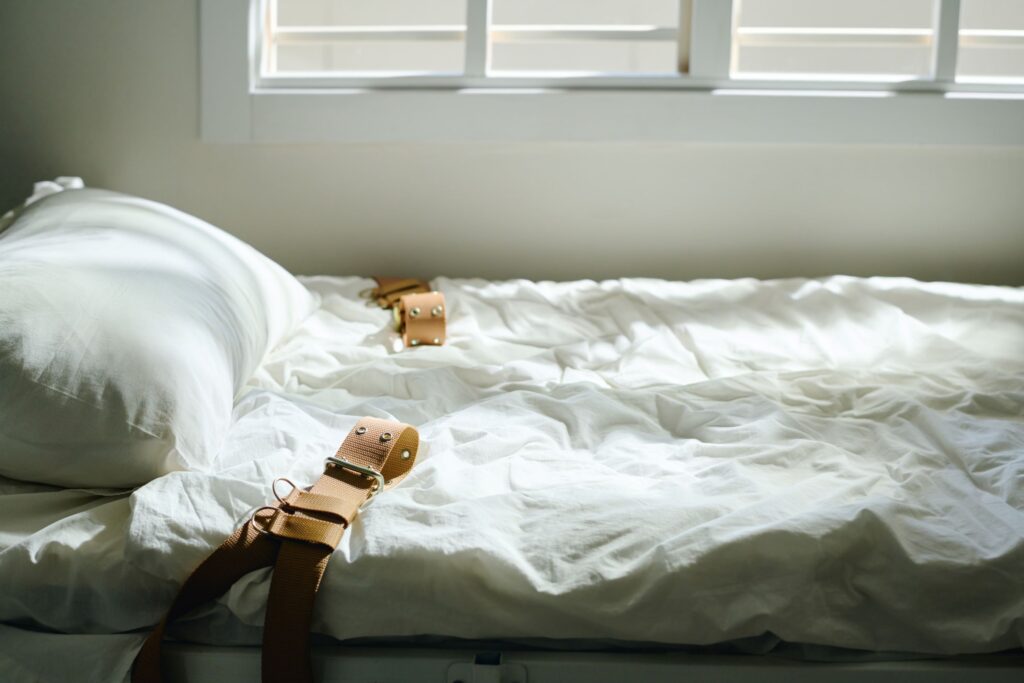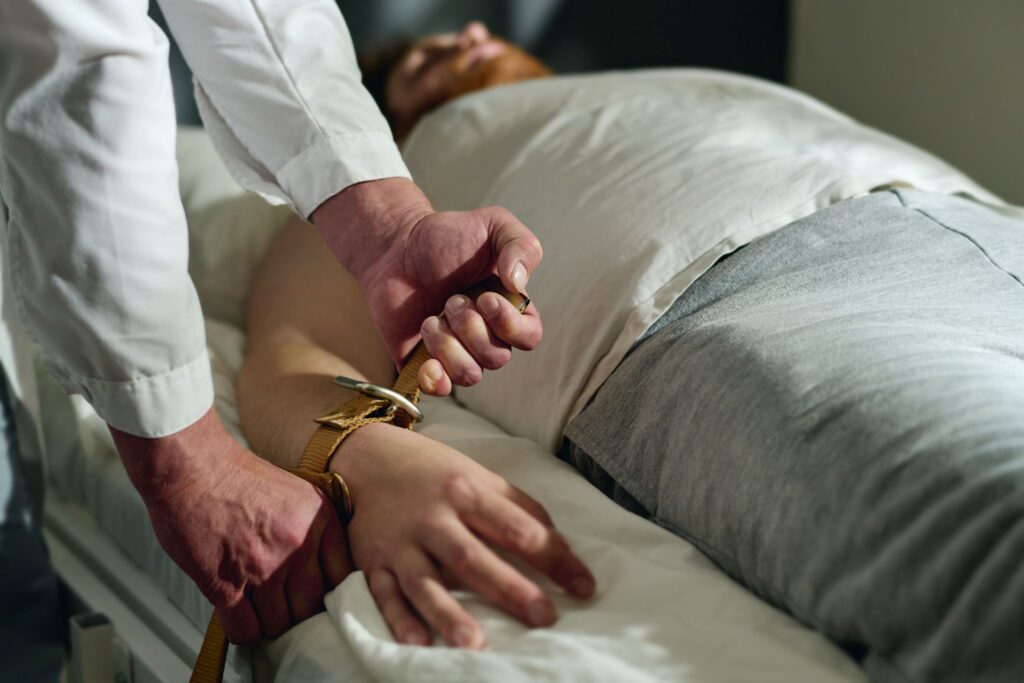In the challenging world of nursing home care, the safety and dignity of your loved one should always come first. Yet when accidents happen, like repeated falls, families may wonder whether restraints could offer protection. It’s a painful thought, imagining someone you love confined to a bed or chair, but it’s one that crosses the minds of many caregivers seeking to prevent harm.
Here’s the truth: while restraints may seem like a quick solution, they can actually lead to more harm than good. Worse, they’re often used for the wrong reasons. This post will walk you through what restraints are, when they’re legally appropriate, and what to do if you suspect they’re being misused. More importantly, we’ll help you understand your rights and how to stand up for your loved one with clarity and confidence.
What is a Restraint?
Restraints are anything that limits the resident’s “freedom of movement,” which is defined further as “any change in place or position for the body or any part of the body that the person is physically able to control”. In layman’s terms, a nursing home staff cannot limit the resident’s ability to move for their own convenience as opposed to the legitimate treatment of the resident.

If a resident cannot be restrained for discipline nor can they be restrained for the convenience of the staff, when can they be restrained? The only time a facility can restrain a resident physically or chemically is if the resident’s medical symptoms warrant the use of restraints for the benefit of the resident. Let me show you how fuzzy that line can get. A resident continues to rise unassisted to go to the bathroom due to an enlarged prostate. This gentleman feels the need to urinate multiple times throughout the night and it is unsafe for him to do so due to various comorbidities that make him a significant fall risk. Throughout the night he rings his call bell and requires assistance to use the bathroom. Staff feels disproportionately burdened throughout the night by this man who is ringing his call bell about once every 90 minutes throughout the overnight shift. The nursing home staff goes to the attending and asks for a “sleep aid” to help the resident sleep through the night. They put an adult diaper on him in case he has any “accidents” as a result of sleeping through a need to toilet. This is a chemical restraint of the resident. If the resident is continent, he should not be put in adult diapers. He should not be drugged to sleep through his urinary urgency. He should be toileted by the staff. Any use of chemical restraints in this scenario is for the exclusive benefit of the staff not the resident.
The Right to Be Free from Restraints
Every nursing home resident has the legal right to live free from unnecessary restraints, whether physical or chemical. This right is protected under federal law and reinforced by Virginia regulations. Restraints should never be used for punishment or convenience. The law answers with a requirement that the facility document clearly the reason for any such restraint and use the least restrictive restraint possible while advising the family and the physician about it. It is required that a facility that wishes to restrain a resident for any period of time obtain an order for the use of the specific type of restraint.
Physical restraints are any device or method that limits movement or access to one’s body. These can include belts, bed rails, tightly tucked sheets, or mechanical chairs that prevent rising.
Chemical restraints involve medications, typically sedatives or antipsychotics, used to control behavior or movement, not to treat a diagnosed medical condition. Medications can be powerful chemical restraints and nursing homes are far more willing to look the other way on these types of restraints. If a drug is administered primarily to make care easier for the staff, it’s considered a restraint.
The use of restraints must always be tied to a clear medical symptom, and even then, only after other alternatives have been tried. There must be a physician’s order outlining exactly what kind of restraint is used, for how long, and why it’s medically necessary.
Restraints are not a shortcut to better care. In fact, they can cause both physical and emotional harm, such as reduced mobility, depression, increased confusion, and injury from struggling against the restraint.
When Restraints Are Prohibited
The law is very clear: restraints cannot be used as a form of discipline or to make things more convenient for the nursing home staff. Unfortunately, that’s exactly how they’re often misused, especially in understaffed or poorly managed facilities.
Let’s be honest—staffing shortages are real. But using restraints as a substitute for proper supervision is never okay. Tying a resident down because they’re restless or giving them medication to keep them quiet through the night is not a solution; it’s a violation of their rights.
In cases where a restraint is medically justified, it must be:
- Specifically ordered by a physician
- Clearly tied to a medical condition
- Time-limited and regularly reviewed
- The least restrictive method possible
Restraints should always be a last resort, not the first response to challenging behavior or mobility issues. Families must be included in the decision-making process, and residents (if capable) have the right to consent or refuse. As an advocate, your job is also to closely monitor the treatments provided to your loved one and make the call as you see it as to whether the facility is restraining your resident or treating a medical symptom.
Understanding the Fine Line
Not everything that limits movement is considered a restraint. And not every restraint is illegal. This is where things can get tricky, especially when safety concerns feel urgent.
For example, a family might request side rails on a bed to prevent nighttime falls. In some cases, that may be a reasonable safety precaution. In others, it could limit movement so severely that it becomes a restraint. Similarly, prescribing a sleep aid for a resident who frequently gets up to use the restroom may seem helpful, but if the real intent is to make the night easier for staff, that crosses a line into chemical restraint.
The difference often comes down to intent and outcome. Is the action being taken to protect the resident based on a medical need? Or is it simply to make things easier or avoid dealing with a difficult behavior?
Facilities may not always explain this clearly, and families may feel unsure whether to push back. But if something doesn’t feel right, if your loved one is suddenly more withdrawn, overly sedated, or shows signs of confusion or bruising, it’s worth asking questions. You have every right to know what care is being provided, why it’s necessary, and what the alternatives are.

Advocating for Your Loved One
Being an advocate for a loved one in a nursing home is not easy, but it is one of the most important roles you can play. If you suspect restraints are being used improperly, start by gathering information. Ask about the care plan, medications, and any physician’s orders. Observe how your loved one is behaving during visits, do they seem drowsy, fearful, or unusually restrained in bed or a chair?
Don’t be afraid to speak up. Start with the nurse in charge and work your way up to the administrator if necessary. Ask direct questions: Why is this restraint in place? Is there a medical diagnosis that justifies it? When was it last reviewed? What alternatives were considered?
If you feel your concerns are being brushed off or downplayed, you have options. You can:
- Request a care plan meeting
- Contact the facility’s ombudsman
- Report the issue to Adult Protective Services
- Consult with a legal team who specializes in nursing home abuse
Even when your concerns feel small, they matter. Sometimes families are told, “This is for their own good,” when really, it’s just what’s easiest for the facility. But easier doesn’t mean better, and it certainly doesn’t mean right.
Conclusion: Knowledge Is the First Step Toward Protection
The empowered advocate has to understand what a restraint is, what it is not, when it is appropriate and when it is not. They also have to understand that restraint analysis is far more than looking to see if your resident is physically tied to an object. Restraints in nursing homes are not just a clinical decision. They’re a question of ethics, dignity, and respect. While there may be rare situations where limited restraint is medically appropriate, they should never be used to control, silence, or sideline a resident.
As someone who loves and advocates for a nursing home resident, your voice matters. Your instincts matter. You’re not being difficult by asking questions—you’re doing what any of us would want someone to do if we were in that position.
At Williams DeLoatche, P.C., we’ve seen the damage that can result when restraints are misused—and we know how to help families fight back. If you’re worried about how your loved one is being treated, or you’re unsure what steps to take next, we’re here to guide you.
Call 757-547-5555 today to schedule a free case evaluation. Your loved one deserves more than silence—they deserve safety, dignity, and a voice.

